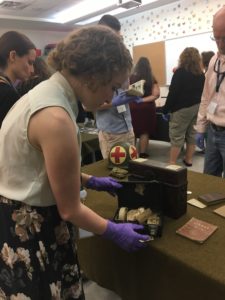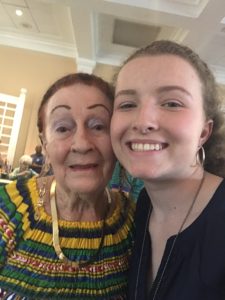It’s my second to last week here at the National WWII Museum and I’ve just had the most interesting discussion with Mr. Owen Glendening, Executive Director of Education & Access. Mr. Glendening has worked for over 30 years in Museum Studies. Now, truly not to diminish the interview in anyway – Mr. Glendening had many interesting points – but there was one thing in particular that stuck with me most.
“Each visitor is sovereign” he said, “they come in with their own morals, their own experiences, and with their own prejudices. It is not my job to change their minds; it is my job to provide them a context that challenges their thinking”.
We then proceeded to discuss this “context” in question, which ultimately encompasses the museum’s exhibits, lighting design, atmosphere, colors chosen, video production, information provided and the order that information is in. Everything a visitor interacts with in any sense – visual, aural, oral, tangible – must work together to challenge traditional thought and accepted public history. That is a role – or the dream – of any museum in the life of the public.
Another cog in the gear of this “context” is the artifacts themselves. Another thing I did this week was shadow in Collections. Now, Collections is a whole other world from the rest of the museum. The people there get to be surrounded by history every day, and they see hundreds more of the artifacts than are on display. Their jobs range from repair of paper artifacts (i.e. torn letter) to deciding which artifacts would convey the right messages about certain exhibits being built (think again, “context”). Turns out my Aunt Judith volunteers in collections, digitizing photographs in pursuit of permanent archival preservation. How cool is that!?
If I were to pursue Museum Studies, I would honestly want to be in Collections. The things these people see. One woman – the same I mentioned last week, Kim Guise – showed me some of the letters received from the front lines. There’s a stark difference between hearing how miserable it was out there to seeing the shaky handwriting of a soldier, describing in detail what it feels like to get frostbite, nearing the Battle of the Bulge. I cannot tell you how close to the writer you immediately become. It is now in no way, shape, or form a random piece of history we remember briefly and pity – it is a life. A boy. A kid who could’ve been my high school classmate and is simultaneously old enough to die for a country. It’s insane to me how much that sinks in when you hold a letter like that in your hands.
That is all, more next week.
Oh, and the lady in the picture s Giustina Maria, from the Netherlands. She noticed my Frida Kahlo necklace and we got to talking about Art History. I told her my name was Elizabeth Mueller and she was like, “Müller! You must be German! Do you speak it?”. So I proceeded to speak ALL the conversational German I had ever retained, and topped it off with a nursery rhyme entitled “Hoppe, Hoppe, Reiter”, which she immediately recognized and sang with me. This lady was a riot and I loved getting to hear a little about her story. Such moments of beauty come from the shared human experience.



There are no comments published yet.